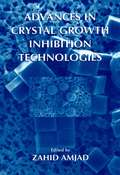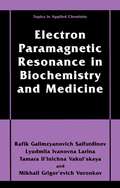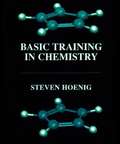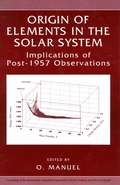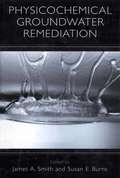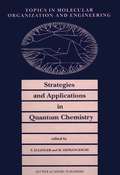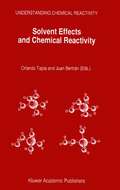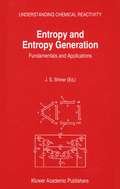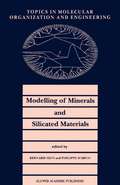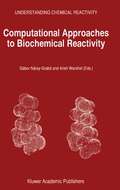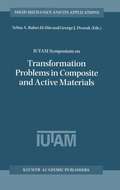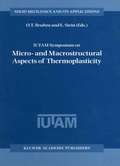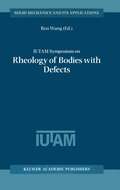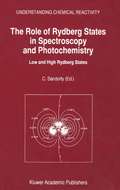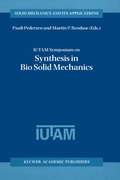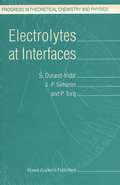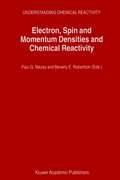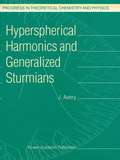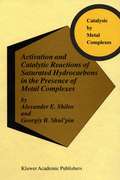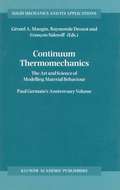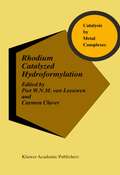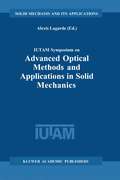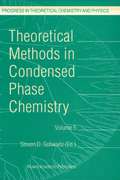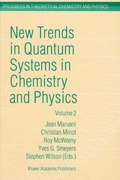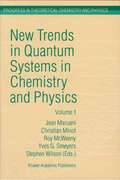- Table View
- List View
Advances in Crystal Growth Inhibition Technologies
by Zahid AmjadIn this book, academic researchers and technologists will find important information on the interaction of polymeric and non-polymeric inhibitors with a variety of scale forming crystals such as calcium phosphates, calcium carbonate, calcium oxalates, barium sulfate, calcium pyrophosphates, and calcium phosphonates. Moreover, the book delivers information to plant managers and formulators who would like to broaden and deepen their knowledge about processes involved in precipitation of sparingly soluble salts and learn more about the inhibitory aspects of various commercially available materials. Furthermore, experienced researchers will obtain fruitful and inspiring ideas from the easily accessible information about overlapping research areas, which will promote discoveries of new inhibitors (synthetic and/or natural) for the currently unmet challenges.
Electron Paramagnetic Resonance in Biochemistry and Medicine (Topics in Applied Chemistry)
by Rafik Galimzyanovich Sajfutdinov Lyudmila Ivanovna Larina Tamara Il'inichna Vakul'skaya Mikhail Grigor'evich VoronkovElectron Paramagnetic Resonance (EPR) spectroscopy - also sometimes termed Electron Spin Resonance spectroscopy - has manifold potential uses in biochemistry and medicine. The paramount importance of EPR spectroscopy applied to biological tissues and fluids is that it identifies the changes in redox processes that contribute to disease. EPR spectroscopy has come a long way from its original use to detect malignant tumors. For example, the development and later refinement of methods of low-temperature registration of biological tissues widened the scope of EPR spectroscopy. Innovations made possible by the introduction of spin labels, probes, and traps made EPR spectroscopy ever more applicable to biochemistry and medicine, to the point where in vivo studies are being carefully considered. This comprehensive book discusses spectra of many tissues and bodily fluids, and the quantitative nature of paramagnetic centers in both normal individuals and patients suffering from a variety of diseases. Special attention is given to the EPR examination of bio-molecules, such as enzymes, polypeptides, vitamins, lipids, hydrocarbons, etc., which play an essential role in human activity. This book will be of great interest to physicians specializing in many different areas. Similarly, biologists, biochemists, biophysicists, and chemists will find this book very useful. It has also been written so that it may be used as a textbook at graduate level.
Basic Training in Chemistry
by Steven HoenigBasic Training in Chemistry is unique in that it gathers into one source the essential information that is usually widely dispersed. This book can be used as a quick reference guide to the different disciplines of Chemistry: the areas covered are General, Inorganic, Organic, and Instrumental Analysis. Although comprehensive in nature, Basic Training in Chemistry is not meant to replace any standard textbook but rather to be a supplement or additional source of information, or even a comprehensive review guide. Basic Training in Chemistry is a useful addition to any academic or commercial laboratory setting where access to a wide variety of information is needed. The book can be an exceptional source of information for the undergraduate or graduate student as well as for the experienced chemist. Anyone needing a single source of information covering several different disciplines will find this book to be an excellent addition to their usual references.
Origin of Elements in the Solar System: Implications of Post-1957 Observations
by Oliver K. ManuelBased on an American Chemical Society Symposium organized by Professors Glenn Seaborg and Oliver Manuel, this volume provides a comprehensive record of different views on this important subject at the end of the 20th century. They have assembled a blend of highly respected experimentalists and theorists from astronomy, geology, meteoritics, planetology and nuclear chemistry and physics to discuss the origin of elements in the solar system. The intent was to include all points of view and let history judge their validity.
Physicochemical Groundwater Remediation (Aids Prevention And Mental Health Ser.)
by James A. SmithAs we transition into the 21st century, it is apparent that this is an exciting time for environmental engineers and scientists studying remediation technologies. There has been a rapid development of new ways to clean-up polluted groundwater. Research activities of the past and next 10 years will have a dramatic impact on the quality of the subsurface environment for the next century. In 20, or even 10 years from now, our approach to subsurface remediation will probably be vastly different than it is today. Many of the emerging technologies presented in this book will form the basis of standard remediation practices of the future. Physicochemical Groundwater Remediation presents detailed information on multiple emerging technologies for the remediation of the contaminated subsurface environment. All of these technologies apply our knowledge of physical and chemical processes to clean up ground water and the unsaturated zone, and many (if not all) of these emerging technologies will help define standard practices in the future. These technologies include in situ sorptive and reactive treatment walls, surfactant-enhanced aquifer remediation, optimization analyses for remediation system design, chemical, electrochemical, and biochemical remediation processes, and monitored natural attenuation. You will learn how palladium catalyzes the dehalogenation of chlorinated solvents. You will find out how barometric pumping can naturally remove significant quantities of volatile organic pollutants from shallow ground water and the unsaturated zone. You can learn about mobilizing non-aqueous phase liquids (NAPLs) without risking significant downward migration of the NAPL. You can find out how processes such as electroosmosis and electromigration can be exploited for groundwater remediation purposes and how zero-valent iron and zeolite treatment walls can be used in situ to treat and control contaminant plume migration. Contributors to this book are experts in groundwater remediation processes, and they represent industry, consulting, academia, and government. If your work involves the clean up of contaminated soil and groundwater, this book is an essential reference to keep you up to date on the most promising new developments in remediation research.
Strategies and Applications in Quantum Chemistry: From Molecular Astrophysics to Molecular Engineering (Topics in Molecular Organization and Engineering #14)
by Y. Ellinger M. DefranceschiAt the time when increasing numbers of chemists are being attracted by the fascination of supposedly easy computing and associated colourful imaging, this book appears as a counterpoint. The first part focuses on fundamental concepts of quantum chemistry, covering MCSCF theory, perturbation treatments, basis set developments, density matrices, wave function instabilities to correlation effects, and momentum space theory. The second part is devoted to more practical studies, ranging from the characterisation of exotic interstellar molecules, the accurate determination of spectroscopic constants, excited states structures and EPR parameters through photochemical and charge-transfer processes, cluster chemistry and fullerenes, muonium chemistry, to the possible prediction of the response of materials to electric fields in view of nonlinear optical applications. Audience: Graduate students and researchers whose work involves quantum chemistry, molecular physics, and materials modelling.
Solvent Effects and Chemical Reactivity (Understanding Chemical Reactivity #17)
by Orlando Tapia Juan BertránThis book gathers original contributions from a selected group of distinguished researchers that are actively working in the theory and practical applications of solvent effects and chemical reactions. The importance of getting a good understanding of surrounding media effects on chemical reacting system is difficult to overestimate. Applications go from condensed phase chemistry, biochemical reactions in vitro to biological systems in vivo. Catalysis is a phenomenon produced by a particular system interacting with the reacting subsystem. The result may be an increment of the chemical rate or sometimes a decreased one. At the bottom, catalytic sources can be characterized as a special kind of surrounding medium effect. The materials involving in catalysis may range from inorganic components as in zeolites, homogenous components, enzymes, catalytic antibodies, and ceramic materials. . With the enormous progress achieved by computing technology, an increasing number of models and phenomenological approaches are being used to describe the effects of a given surrounding medium on the electronic properties of selected subsystem. A number of quantum chemical methods and programs, currently applied to calculate in vacuum systems, have been supplemented with a variety of model representations. With the increasing number of methodologies applied to this important field, it is becoming more and more difficult for non-specialist to cope with theoretical developments and extended applications. For this and other reasons, it is was deemed timely to produce a book where methodology and applications were analyzed and reviewed by leading experts in the field.
Entropy and Entropy Generation: Fundamentals and Applications (Understanding Chemical Reactivity #18)
by J. S. ShinerEntropy and entropy generation play essential roles in our understanding of many diverse phenomena ranging from cosmology to biology. Their importance is manifest in areas of immediate practical interest such as the provision of global energy as well as in others of a more fundamental flavour such as the source of order and complexity in nature. They also form the basis of most modern formulations of both equilibrium and nonequilibrium thermodynamics. Today much progress is being made in our understanding of entropy and entropy generation in both fundamental aspects and application to concrete problems. The purpose of this volume is to present some of these recent and important results in a manner that not only appeals to the entropy specialist but also makes them accessible to the nonspecialist looking for an overview of the field. This book contains fourteen contributions by leading scientists in their fields. The content covers such topics as quantum thermodynamics, nonlinear processes, gravitational and irreversible thermodynamics, the thermodynamics of Taylor dispersion, higher order transport, the mesoscopic theory of liquid crystals, simulated annealing, information and biological aspects, global energy, photovoltaics, heat and mass transport and nonlinear electrochemical systems. Audience: This work will be of value to physicists, chemists, biologists and engineers interested in the theory and applications of entropy and its generation.
Modelling of Minerals and Silicated Materials (Topics in Molecular Organization and Engineering #15)
by B. Silvi P. D'ArcoThe modeling of minerals and silicated materials is a. difficult challenge faced by Solid StatePhysics, Quantum Chemistry and Molecular Dynamics communities. The difficulty of such a modeling is due to the wide diversity of elements, including heavy atoms,and types of bonding involved in such systems. Moreover, one has to consider infinite systems: either perfect cr- tals or glasses and melts. In the solid state a given chemical composition gives rise to numerous polymorphs, geometricallycloselyrelated. These polymorphs have very similar energies and related thermodynamical pr- erties which explain the complexity of their phase diagrams. The modeling of silicates and minerals covers a wide field of applications ranging from basic research to technology, from Solid State Physics to Earth and Planetary science. The use of modeling techniques yields information of different nature. In the case of chemical studies, we can mention inv- tigations on catalytic processes occurring on surfaces and in zeolite cages. These calculations find possible applications in chemical engineering, in particular in the oil industry.
Computational Approaches to Biochemical Reactivity (Understanding Chemical Reactivity #19)
by Arieh Warshel Gábor Náray-SzabóA quantitative description of the action of enzymes and other biological systems is both a challenge and a fundamental requirement for further progress in our und- standing of biochemical processes. This can help in practical design of new drugs and in the development of artificial enzymes as well as in fundamental understanding of the factors that control the activity of biological systems. Structural and biochemical st- ies have yielded major insights about the action of biological molecules and the mechanism of enzymatic reactions. However it is not entirely clear how to use this - portant information in a consistent and quantitative analysis of the factors that are - sponsible for rate acceleration in enzyme active sites. The problem is associated with the fact that reaction rates are determined by energetics (i. e. activation energies) and the available experimental methods by themselves cannot provide a correlation - tween structure and energy. Even mutations of specific active site residues, which are extremely useful, cannot tell us about the totality of the interaction between the active site and the substrate. In fact, short of inventing experiments that allow one to measure the forces in enzyme active sites it is hard to see how can one use a direct experimental approach to unambiguously correlate the structure and function of enzymes. In fact, in view of the complexity of biological systems it seems that only computers can handle the task of providing a quantitative structure-function correlation.
IUTAM Symposium on Transformation Problems in Composite and Active Materials: Proceedings of the IUTAM Symposium held in Cairo, Egypt, 9–12 March 1997 (Solid Mechanics and Its Applications #60)
by Yehia A. Bahei-El-Din George J. DvorakThe field of composite materials has seen substantial development in the past decade, New composite systems are being continually developed for various applications. Among such systems are metal, intermetallic, and superalloy matrix composites, carbon-carbon composites as well as polymer matrix composites. At the same time, a new discipline has emerged of active or smart materials, which are often constructed as composite or heterogeneous media and structures. One unifying theme in these diverse systems is the influence that uncoupled and coupled eigenfields or transformation fields exert on the various types of overall response, as well as on the respective phase responses. Problems of this kind are currently considered by different groups which may not always appreciate the similarities of the problems involved. The purpose of the IUTAM Symposium on Transformation Problems in Composite and Active Materials held in Cairo, Egypt from March 10 to 12, 1997 was to bring together representatives of the different groups so that they may interact and explore common aspects of these seemingly different problem areas. New directions in micromechanics research in both composite and active materials were also explored in the symposium. Specifically, invited lectures in the areas of inelastic behavior of composite materials, shape memory effects, functionally graded materials, transformation problems in composite structures, and adaptive structures were delivered and discussed during the three-day meeting. This book contains the printed contributions to the IUTAM Symposium.
IUTAM Symposium on Micro- and Macrostructural Aspects of Thermoplasticity: Proceedings of the IUTAM Symposium held in Bochum, Germany, 25–29 August 1997 (Solid Mechanics and Its Applications #62)
by O. T. Bruhns E. SteinProceedings of the IUTAM Symposium held in Bochum, Germany, 25-29 August 1997
IUTAM Symposium on Rheology of Bodies with Defects: Proceedings of the IUTAM Symposium held in Beijing, China, 2–5 September 1997 (Solid Mechanics and Its Applications #64)
by Ren Ren WangThe IUTAM Symposium on Rheology of Bodies with Defects was held in Beijing in September, 1997. It was aimed at the development of Rheology in Solid Mechanics. Rheology is classified in Applied Mechanics Review under fluid mechanics, however, in its broadest content as was envisaged in its earlier days, it covers the whole spectrum of material behavior from elasticity, plasticity, and fluid mechanics to gas dynamics. It was thought of as a branch of continuum mechanics, but emphasized the physical aspects of different materials, and frequently proceeded from basic physical principles. As the temperature rises, the distinction between solid and fluid, and the distinction between their micro-mechanical movements, become blurred. The physical description of such materials and their movements must be based on the thermodynamic principles of state variable theory; the classical division between solid and fluid mechanics disappears. Under the classification adopted by Applied Mechanics Reviews, the subjects dealt with in this symposium come closer to viscoelasticity and viscoplasticity, especially close to the subdivision of creep dealing with creep rupture. The symposium focused at building a bridge between macroscopic and microscopic research on damage and fracture behavior of defective bodies made of metal, polymer, composite and other viscoelastic materials. Two different approaches are presented at the symposium. The first is a continuum damage theory for time-dependent evolution of defects at the macro/meso/microscopic levels.
The Role of Rydberg States in Spectroscopy and Photochemistry: Low and High Rydberg States (Understanding Chemical Reactivity #20)
by C. SándorfyThe aim of this volume is to offer a balanced overview of molecular Rydberg spectroscopy as it has developed over recent decades. Recent evolution has split Rydberg spectroscopy into two apparently distinct fields: the one concerns the low (n=3-5) Rydberg states, the other the very high (typically n>150) Rydberg states. The former is aimed at spectral levels where Rydberg, valence-shell, and intermediate-type states interact, with a variety of photochemical consequences. The latter considers states extremely close to the ionization limit, from whereionization is possible with a very slight amount of additional energy. Recently developed techniques make it possible to produce ions in well-defined electronic, vibrational and rotational states, including states resulting from spin-orbit or Jahn-Teller splitting. It is then possible to study the structure and reactions of such state-selected ions as well as those of the corresponding neutral molecules. These techniques amount to badly needed high resolution photoelectron spectroscopy.
IUTAM Symposium on Synthesis in Bio Solid Mechanics: Proceedings of the IUTAM Symposium held in Copenhagen, Denmark, 24–27 May 1998 (Solid Mechanics and Its Applications #69)
by Pauli Pedersen Martin P. BendsøeThis book contains the edited version of invited lectures presented at the IUTAM-Sym- sium Synthesis in Bio Solid Mechanics, held at Hotel Frederiksdal, Virum (Copenhagen), Denmark, May 24 to May 27, 1998. The symposium was attended by 48 scientist from 14 countries. Biomechanics has been a very active research area in the last 25 years and covers a very broad class of problems. The present symposium concentrated on the solid mechanics - main of biomechanics, where important problems of synthesis presently are an active and challenging part. Characteristics of biomechanical materials are not only the inhomogeneity and anisotropy, but also the capability to change in relation to actual use. These living materials call for new methods of analysis and also new methods for synthesis. By the synthesis in this context is meant design of implants or artificial control of material growth. Bone mechanics is closely related to recent work on analysis and design of microstructural anisotropic materials. Also, recent work in shape design can to some extent be useful in the more complicated problems of biomechanics. Here interface problems play an essential role. The symposium brought together scientists from mechanics, mathematics and medicine.
Electrolytes at Interfaces (Progress in Theoretical Chemistry and Physics #1)
by S. Durand-Vidal J.-P. Simonin P. TurqThe aim of this book is to provide the reader with a modern presentation of ionic solutions at interfaces, for physical chemists, chemists and theoretically oriented experimentalists in this field. The discussion is mainly on the structural and thermodynamic properties, in relation to presently available statistical mechanical models. Some dynamic properties are also presented, at a more phenomenological level. The initial chapters are devoted to the presentation of some basic concepts for bulk properties: hydrodynamic interactions, electrostatics, van der Waals forces and thermodynamics of ionic solutions in the framework of a particular model: the mean spherical approximation (MSA). Specific features of interfaces are then discussed: experimental techniques such as in-situ X-ray diffraction, STM and AFM microscopy are described. Ions at liquid/air, liquid/metal and liquid/liquid interfaces are considered from the experimental and theoretical viewpoint. Lastly some dynamic (transport) properties are included, namely the self-diffusion and conductance of small colloids (polyelectrolytes and micelles) and the kinetics of solute transfer at free liquid/liquid interfaces.
Electron, Spin and Momentum Densities and Chemical Reactivity (Understanding Chemical Reactivity #21)
by Paul G. Mezey Beverly E. RobertsonThe electron density of a non-degenerate ground state system determines essentially all physical properties of the system. This statement of the Hohenberg–Kohn theorem of Density Functional Theory plays an exceptionally important role among all the fundamental relations of Molecular Physics. In particular, the electron density distribution and the dynamic properties of this density determine both the local and global reactivities of molecules. High resolution experimental electron densities are increasingly becoming available for more and more molecules, including macromolecules such as proteins. Furthermore, many of the early difficulties with the determination of electron densities in the vicinity of light nuclei have been overcome. These electron densities provide detailed information that gives important insight into the fundamentals of molecular structure and a better understanding of chemical reactions. The results of electron density analysis are used in a variety of applied fields, such as pharmaceutical drug discovery and biotechnology. If the functional form of a molecular electron density is known, then various molecular properties affecting reactivity can be determined by quantum chemical computational techniques or alternative approximate methods.
Hyperspherical Harmonics and Generalized Sturmians (Progress in Theoretical Chemistry and Physics #4)
by John S. AveryActivation and Catalytic Reactions of Saturated Hydrocarbons in the Presence of Metal Complexes (Catalysis by Metal Complexes #21)
by A.E. Shilov Georgiy B. Shul'pinhemistry is the science about breaking and forming of bonds between atoms. One of the most important processes for organic chemistry is breaking bonds C–H, as well as C–C in various compounds, and primarily, in hydrocarbons. Among hydrocarbons, saturated hydrocarbons, alkanes (methane, ethane, propane, hexane etc. ), are especially attractive as substrates for chemical transformations. This is because, on the one hand, alkanes are the main constituents of oil and natural gas, and consequently are the principal feedstocks for chemical industry. On the other hand, these substances are known to be the less reactive organic compounds. Saturated hydrocarbons may be called the “noble gases of organic chemistry” and, if so, the first representative of their family – methane – may be compared with extremely inert helium. As in all comparisons, this parallel between noble gases and alkanes is not fully accurate. Indeed the transformations of alkanes, including methane, have been known for a long time. These reactions involve the interaction with molecular oxygen from air (burning – the main source of energy!), as well as some mutual interconversions of saturated and unsaturated hydrocarbons. However, all these transformations occur at elevated temperatures (higher than 300–500 °C) and are usually characterized by a lack of selectivity. The conversion of alkanes into carbon dioxide and water during burning is an extremely valuable process – but not from a chemist viewpoint.
Continuum Thermomechanics: The Art and Science of Modelling Material Behaviour (Solid Mechanics and Its Applications #76)
by Gérard A. MauginContributed by world-renowned specialists on the occasion of Paul Germain's 80th birthday, this unique book reflects the foundational works and the intellectual influence of this author. It presents the realm of modern thermomechanics with its extraordinary wealth of applications to the behaviour of materials, whether solid or fluid. The thirty-one contributions follow an easygoing autobiographical sketch by Paul Germain, and highlight the power and richness of a methodological approach to the phenomenology of many materials. This approach combines harmoniously thermodynamics and continuum theory in order to provide exploitable, thermodynamically admissible models of a large variety of behaviours and phenomena, including those of diffusion, thermoelasticity, viscoplasticity, relaxation, hysteresis, wetting, shape-memory effects, growth, phase transitions, stability, fracture, shocks, machining of materials, microstructured solids, complex fluids, etc. Especially aimed at graduate students, researchers, and engineers in mechanical engineering and materials science, this book also presents the state of the art in an active field of research and opens new horizons in other scientific fields, such as applied mathematics and applied physics, because of the intellectual satisfaction and remarkable efficiency provided by the advocated approach.
Rhodium Catalyzed Hydroformylation (Catalysis by Metal Complexes #22)
by Piet W. N. M. Van Leeuwen Carmen ClaverIn the last decade there have been numerous advances in the area of rhodium-catalyzed hydroformylation, such as highly selective catalysts of industrial importance, new insights into mechanisms of the reaction, very selective asymmetric catalysts, in situ characterization and application to organic synthesis. The views on hydroformylation which still prevail in the current textbooks have become obsolete in several respects. Therefore, it was felt timely to collect these advances in a book. The book contains a series of chapters discussing several rhodium systems arranged according to ligand type, including asymmetric ligands, a chapter on applications in organic chemistry, a chapter on modern processes and separations, and a chapter on catalyst preparation and laboratory techniques. This book concentrates on highlights, rather than a concise review mentioning all articles in just one line. The book aims at an audience of advanced students, experts in the field, and scientists from related fields. The didactic approach also makes it useful as a guide for an advanced course.
IUTAM Symposium on Advanced Optical Methods and Applications in Solid Mechanics: Proceedings of the IUTAM Symposium held in Futuroscope, Poitiers, France, August 31st–September 4th, 1998 (Solid Mechanics and Its Applications #82)
by Alexis LagardeThe request to organize under its patronage at Poitiers in 1998 a Symposium entitled “Advanced Optical Methods and Applications in Solid Mechanics” by the International Union of Theoretical and Applied Mechanics (I.U.T.A.M.) was well received for the following two reasons. First, for nearly 20 years no Symposium devoted to optical methods in solids had been organized. Second, recent advances in digital image processing provided many new applications which are described in the following. We have the honour to present here the proceedings of this Symposium. st th The Symposium took place from august 31 to September 4 at the Institut International de la Prospective in Futuroscope near Poitiers. A significant number of internationally renowned specialists had expressed their wish to participate in this meeting. The Scientific Committee proposed 16 general conferences and selected 33 regular lectures and 17 poster presentations. Papers corresponding to posters are not differentiated in the proceedings from those that were presented orally. It is worth noting that a total of 80 participants, representing 16 countries, registered for this symposium.. The Scientific Committee deserves praise for attracting a significant number of young scientists, both as authors and as participants. Let us add our warm acknowledgements to Professor J.W. Dally and to Professor A.S. Kobayashi who, throughout the symposium preparation time, brought us valuable help.
Theoretical Methods in Condensed Phase Chemistry (Progress in Theoretical Chemistry and Physics #5)
by S. D. SchwartzThis book is meant to provide a window on the rapidly growing body of theoretical studies of condensed phase chemistry. A brief perusal of physical chemistry journals in the early to mid 1980’s will find a large number of theor- ical papers devoted to 3-body gas phase chemical reaction dynamics. The recent history of theoretical chemistry has seen an explosion of progress in the devel- ment of methods to study similar properties of systems with Avogadro’s number of particles. While the physical properties of condensed phase systems have long been principle targets of statistical mechanics, microscopic dynamic theories that start from detailed interaction potentials and build to first principles predictions of properties are now maturing at an extraordinary rate. The techniques in use range from classical studies of new Generalized Langevin Equations, semicl- sical studies for non-adiabatic chemical reactions in condensed phase, mixed quantum classical studies of biological systems, to fully quantum studies of m- els of condensed phase environments. These techniques have become sufficiently sophisticated, that theoretical prediction of behavior in actual condensed phase environments is now possible. and in some cases, theory is driving development in experiment. The authors and chapters in this book have been chosen to represent a wide variety in the current approaches to the theoretical chemistry of condensed phase systems. I have attempted a number of groupings of the chapters, but the - versity of the work always seems to frustrate entirely consistent grouping.
New Trends in Quantum Systems in Chemistry and Physics: Volume 2 Advanced Problems and Complex Systems Paris, France, 1999 (Progress in Theoretical Chemistry and Physics #7)
by R. McWeeny Christian Minot Y. G. Smeyers Stephen Wilson J. MaruaniThese two volumes collect thirty-eight selected papers from the scientific contributions presented at the Fourth European Workshop on Quantum Systems in Chemistry and Physics (QSCP-IV), held in Marly-le-Roi (France) in April 22-27, 1999. A total of one hundred and fifteen scientists attended the workshop, 99 from Europe and 16 from the rest of the world. They discussed the state of the art, new trends, and future evolution of the methods and applications. The workshop was held in the old town of Marly-le-Roi, which lies to the West of Paris between the historic centres of Saint-Germain-en-Laye and Versailles. Participants were housed at the National Youth Institute, where over sixty lectures were given by l- ding members of the scientific community; in addition, over sixty posters were presented in two very animated sessions. We are grateful to the oral speakers and to the poster p- senters for making the workshop such an stimulating experience. The social programme was also memorable – and not just for the closing banquet, which was held at the French Senate House. We are sure that participants will long remember their visit to the 'Musée des Antiquités Nationales': created by Napoleon III at the birthplace of Louis XIV, this museum boasts one of the world finest collections of archeological artifacts. The Marly-le-Roi workshop followed the format established at the three previous meetings, organized by Prof.
New Trends in Quantum Systems in Chemistry and Physics: Volume 1 Basic Problems and Model Systems Paris, France, 1999 (Progress in Theoretical Chemistry and Physics #6)
by R. McWeeny Christian Minot Y. G. Smeyers Stephen Wilson J. MaruaniThese two volumes collect thirty-eight selected papers from the scientific contributions presented at the Fourth European Workshop on Quantum Systems in Chemistry and Physics (QSCP-IV), held in Marly-le-Roi (France) in April 22-27, 1999, A total ofone hundred and fifteen scientists attended the workshop, 99 from Europe and 16 from the rest ofthe world. They discussed the state of the art, new trends, and future evolution of the methods and applications. The workshop was held in the old town of Marly-le-Roi, which lies to the West of Paris between the historic centres of Saint-Germain-en-Laye and Versailles. Participants were housed at the National Youth Institute, where over sixty lectures were given by l- ding members ofthe scientific community; in addition, over sixty posters were presented in two very animated sessions. We are grateful to the oral speakers and to the poster p- senters for making the workshop such an stimulating experience. The social programme was also memorable - and notjust for the closing banquet, which was held at the French Senate House. We are sure that participants will long remember their visit to the 'Musée des Antiquités Nationales': created by Napoleon III at the birthplace ofLouis XIV, this museum boasts one ofthe world finest collections ofarcheological artifacts. The Marly-le-Roi workshop followed the format established at the three previous meetings, organized by Prof.
